Understanding and Leading Change: Starbucks Case Study Report
VerifiedAdded on 2023/01/18
|17
|4838
|87
Report
AI Summary
This report delves into Starbucks' approach to change management, comparing its strategies and operations with those of Costa Coffee. It explores how organizational structure changes, such as adopting a flat structure, impact the company's strategy and HRM. The report identifies both internal drivers of change, like cultural differences and financial management, and external drivers, including political, economic, social, and technological factors. It then evaluates the barriers to change and proposes the use of the PDCA model to mitigate negative impacts. The report offers a comprehensive analysis of leadership approaches and decision-making in the context of change, providing insights into Starbucks' adaptability and sustainability within a competitive market.
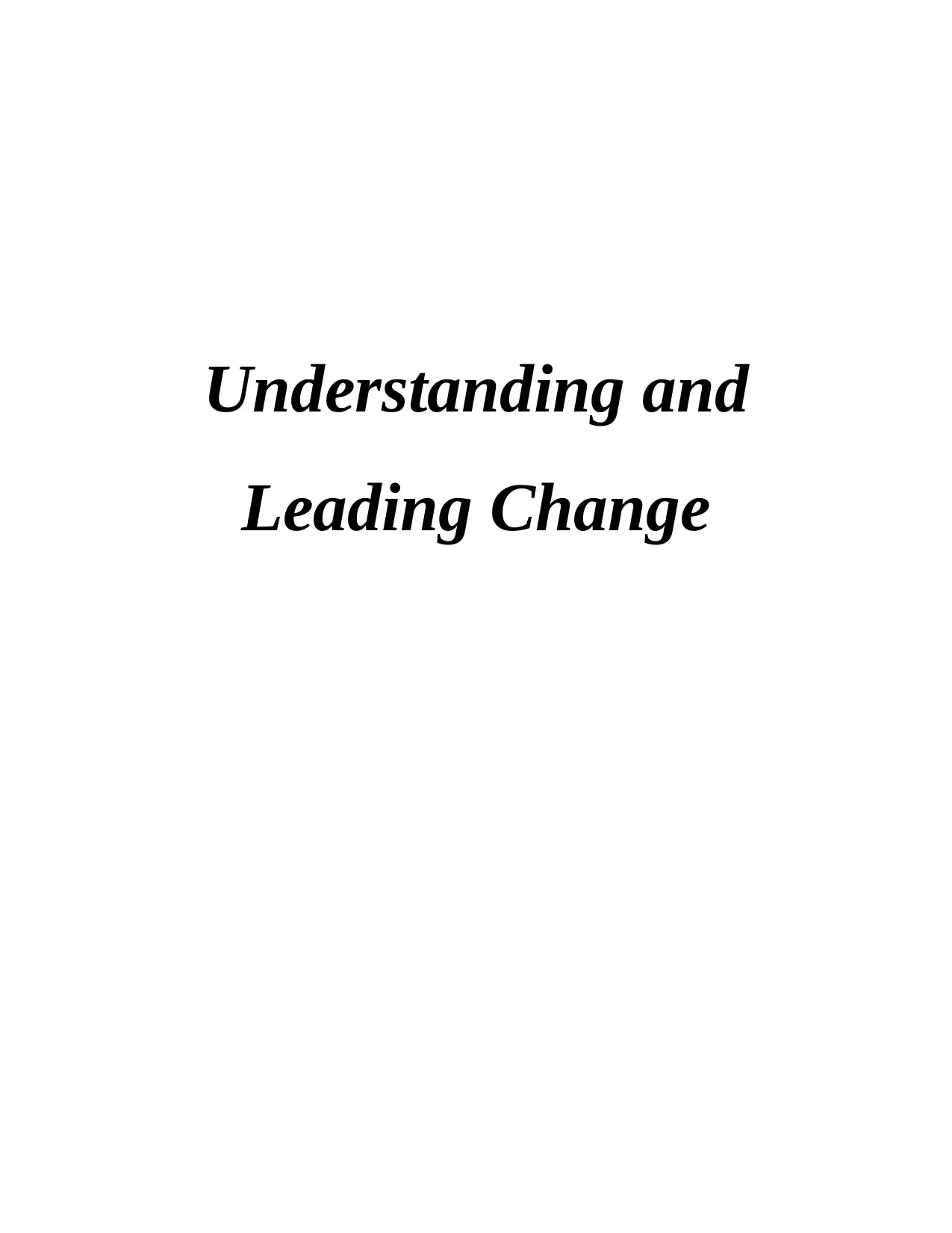
Understanding and
Leading Change
Leading Change
Paraphrase This Document
Need a fresh take? Get an instant paraphrase of this document with our AI Paraphraser

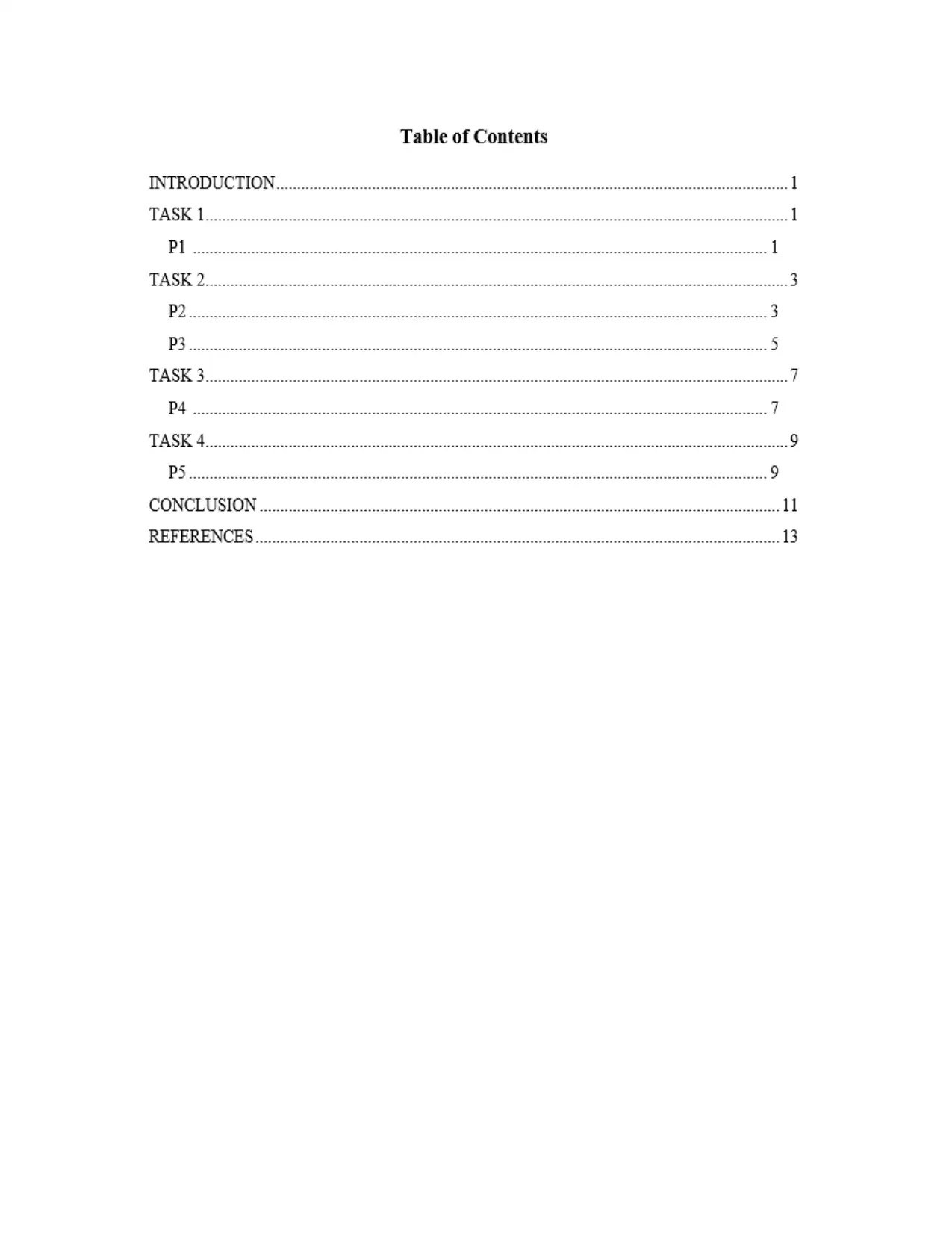
You're viewing a preview
Unlock full access by subscribing today!
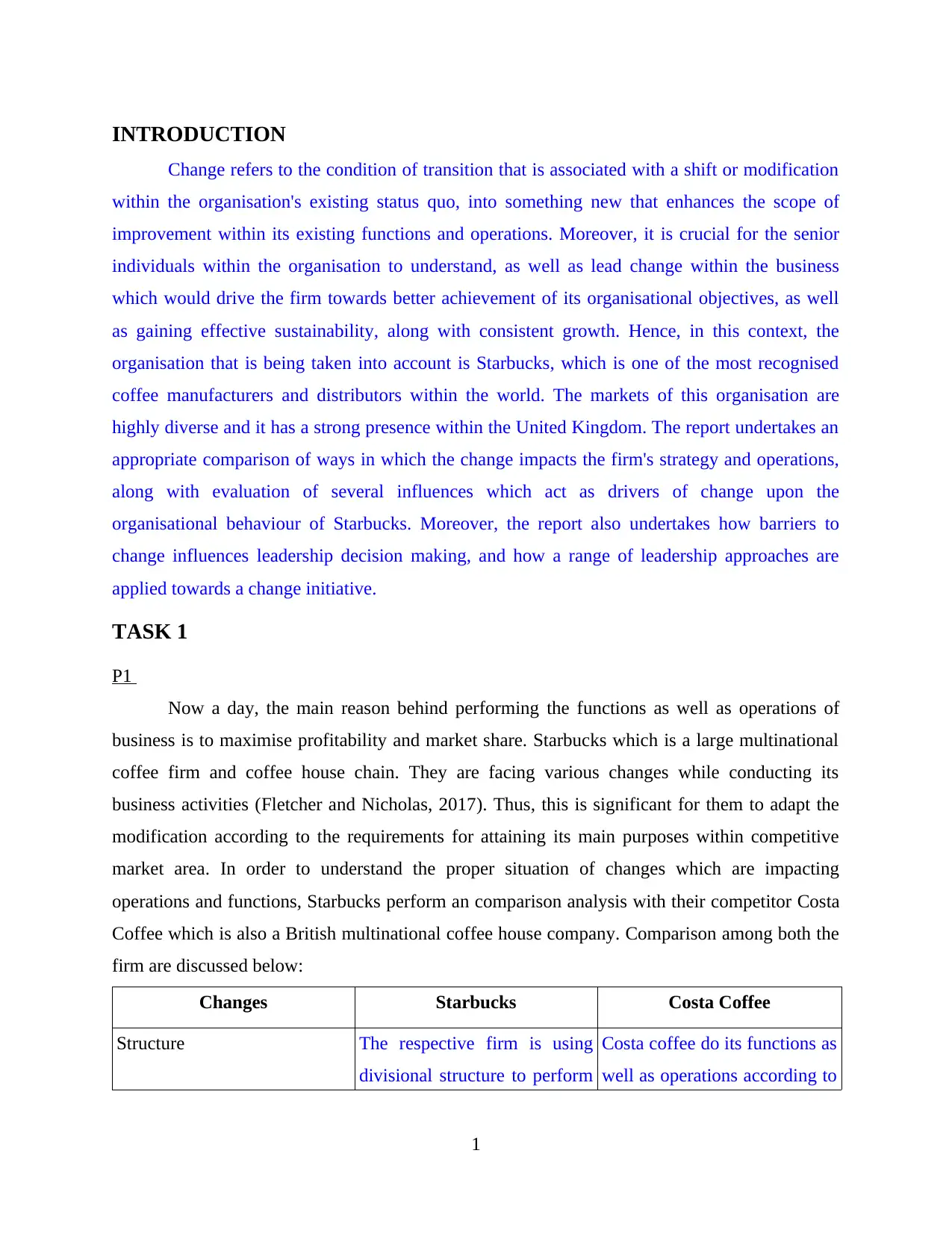
INTRODUCTION
Change refers to the condition of transition that is associated with a shift or modification
within the organisation's existing status quo, into something new that enhances the scope of
improvement within its existing functions and operations. Moreover, it is crucial for the senior
individuals within the organisation to understand, as well as lead change within the business
which would drive the firm towards better achievement of its organisational objectives, as well
as gaining effective sustainability, along with consistent growth. Hence, in this context, the
organisation that is being taken into account is Starbucks, which is one of the most recognised
coffee manufacturers and distributors within the world. The markets of this organisation are
highly diverse and it has a strong presence within the United Kingdom. The report undertakes an
appropriate comparison of ways in which the change impacts the firm's strategy and operations,
along with evaluation of several influences which act as drivers of change upon the
organisational behaviour of Starbucks. Moreover, the report also undertakes how barriers to
change influences leadership decision making, and how a range of leadership approaches are
applied towards a change initiative.
TASK 1
P1
Now a day, the main reason behind performing the functions as well as operations of
business is to maximise profitability and market share. Starbucks which is a large multinational
coffee firm and coffee house chain. They are facing various changes while conducting its
business activities (Fletcher and Nicholas, 2017). Thus, this is significant for them to adapt the
modification according to the requirements for attaining its main purposes within competitive
market area. In order to understand the proper situation of changes which are impacting
operations and functions, Starbucks perform an comparison analysis with their competitor Costa
Coffee which is also a British multinational coffee house company. Comparison among both the
firm are discussed below:
Changes Starbucks Costa Coffee
Structure The respective firm is using
divisional structure to perform
Costa coffee do its functions as
well as operations according to
1
Change refers to the condition of transition that is associated with a shift or modification
within the organisation's existing status quo, into something new that enhances the scope of
improvement within its existing functions and operations. Moreover, it is crucial for the senior
individuals within the organisation to understand, as well as lead change within the business
which would drive the firm towards better achievement of its organisational objectives, as well
as gaining effective sustainability, along with consistent growth. Hence, in this context, the
organisation that is being taken into account is Starbucks, which is one of the most recognised
coffee manufacturers and distributors within the world. The markets of this organisation are
highly diverse and it has a strong presence within the United Kingdom. The report undertakes an
appropriate comparison of ways in which the change impacts the firm's strategy and operations,
along with evaluation of several influences which act as drivers of change upon the
organisational behaviour of Starbucks. Moreover, the report also undertakes how barriers to
change influences leadership decision making, and how a range of leadership approaches are
applied towards a change initiative.
TASK 1
P1
Now a day, the main reason behind performing the functions as well as operations of
business is to maximise profitability and market share. Starbucks which is a large multinational
coffee firm and coffee house chain. They are facing various changes while conducting its
business activities (Fletcher and Nicholas, 2017). Thus, this is significant for them to adapt the
modification according to the requirements for attaining its main purposes within competitive
market area. In order to understand the proper situation of changes which are impacting
operations and functions, Starbucks perform an comparison analysis with their competitor Costa
Coffee which is also a British multinational coffee house company. Comparison among both the
firm are discussed below:
Changes Starbucks Costa Coffee
Structure The respective firm is using
divisional structure to perform
Costa coffee do its functions as
well as operations according to
1
Paraphrase This Document
Need a fresh take? Get an instant paraphrase of this document with our AI Paraphraser
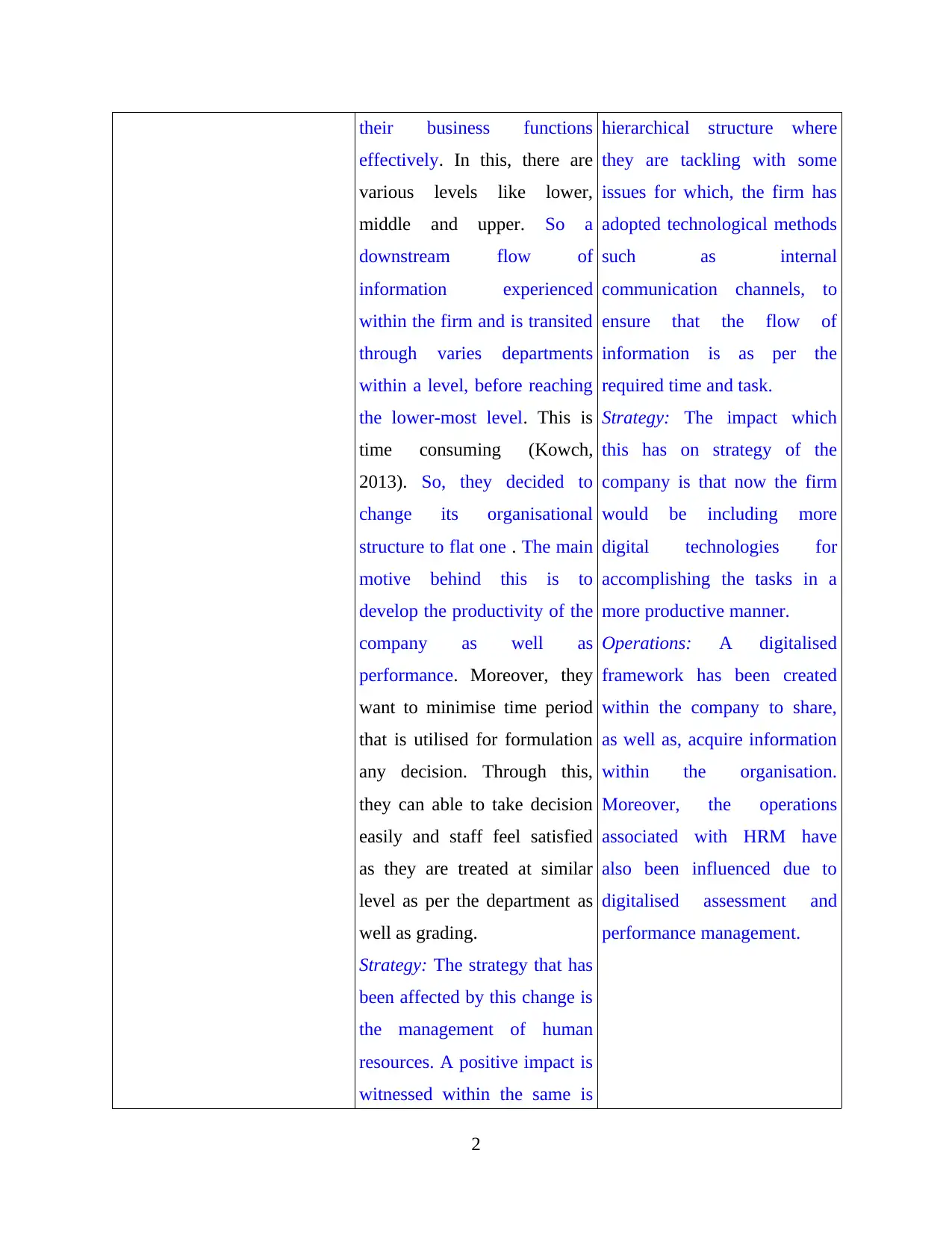
their business functions
effectively. In this, there are
various levels like lower,
middle and upper. So a
downstream flow of
information experienced
within the firm and is transited
through varies departments
within a level, before reaching
the lower-most level. This is
time consuming (Kowch,
2013). So, they decided to
change its organisational
structure to flat one . The main
motive behind this is to
develop the productivity of the
company as well as
performance. Moreover, they
want to minimise time period
that is utilised for formulation
any decision. Through this,
they can able to take decision
easily and staff feel satisfied
as they are treated at similar
level as per the department as
well as grading.
Strategy: The strategy that has
been affected by this change is
the management of human
resources. A positive impact is
witnessed within the same is
hierarchical structure where
they are tackling with some
issues for which, the firm has
adopted technological methods
such as internal
communication channels, to
ensure that the flow of
information is as per the
required time and task.
Strategy: The impact which
this has on strategy of the
company is that now the firm
would be including more
digital technologies for
accomplishing the tasks in a
more productive manner.
Operations: A digitalised
framework has been created
within the company to share,
as well as, acquire information
within the organisation.
Moreover, the operations
associated with HRM have
also been influenced due to
digitalised assessment and
performance management.
2
effectively. In this, there are
various levels like lower,
middle and upper. So a
downstream flow of
information experienced
within the firm and is transited
through varies departments
within a level, before reaching
the lower-most level. This is
time consuming (Kowch,
2013). So, they decided to
change its organisational
structure to flat one . The main
motive behind this is to
develop the productivity of the
company as well as
performance. Moreover, they
want to minimise time period
that is utilised for formulation
any decision. Through this,
they can able to take decision
easily and staff feel satisfied
as they are treated at similar
level as per the department as
well as grading.
Strategy: The strategy that has
been affected by this change is
the management of human
resources. A positive impact is
witnessed within the same is
hierarchical structure where
they are tackling with some
issues for which, the firm has
adopted technological methods
such as internal
communication channels, to
ensure that the flow of
information is as per the
required time and task.
Strategy: The impact which
this has on strategy of the
company is that now the firm
would be including more
digital technologies for
accomplishing the tasks in a
more productive manner.
Operations: A digitalised
framework has been created
within the company to share,
as well as, acquire information
within the organisation.
Moreover, the operations
associated with HRM have
also been influenced due to
digitalised assessment and
performance management.
2
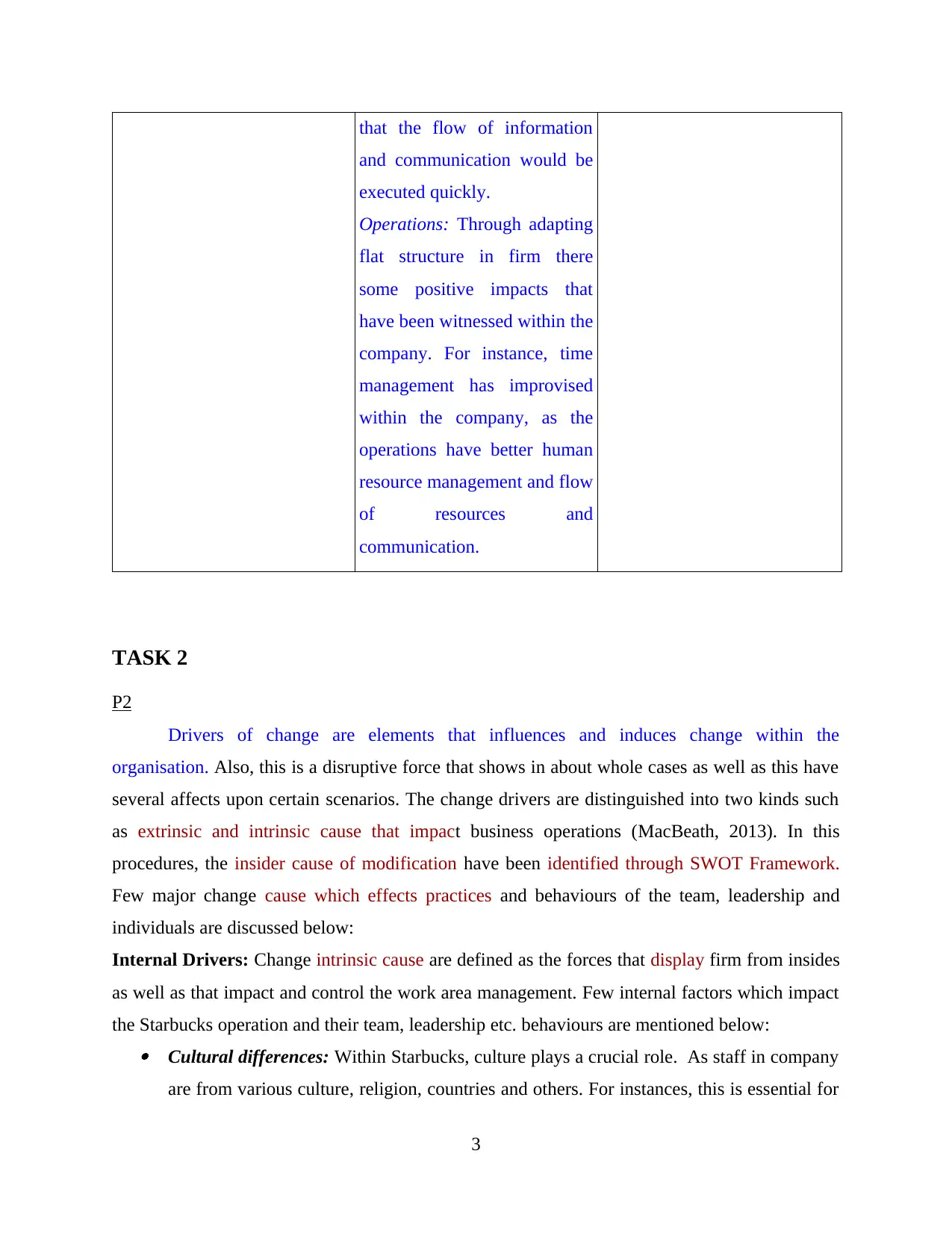
that the flow of information
and communication would be
executed quickly.
Operations: Through adapting
flat structure in firm there
some positive impacts that
have been witnessed within the
company. For instance, time
management has improvised
within the company, as the
operations have better human
resource management and flow
of resources and
communication.
TASK 2
P2
Drivers of change are elements that influences and induces change within the
organisation. Also, this is a disruptive force that shows in about whole cases as well as this have
several affects upon certain scenarios. The change drivers are distinguished into two kinds such
as extrinsic and intrinsic cause that impact business operations (MacBeath, 2013). In this
procedures, the insider cause of modification have been identified through SWOT Framework.
Few major change cause which effects practices and behaviours of the team, leadership and
individuals are discussed below:
Internal Drivers: Change intrinsic cause are defined as the forces that display firm from insides
as well as that impact and control the work area management. Few internal factors which impact
the Starbucks operation and their team, leadership etc. behaviours are mentioned below: Cultural differences: Within Starbucks, culture plays a crucial role. As staff in company
are from various culture, religion, countries and others. For instances, this is essential for
3
and communication would be
executed quickly.
Operations: Through adapting
flat structure in firm there
some positive impacts that
have been witnessed within the
company. For instance, time
management has improvised
within the company, as the
operations have better human
resource management and flow
of resources and
communication.
TASK 2
P2
Drivers of change are elements that influences and induces change within the
organisation. Also, this is a disruptive force that shows in about whole cases as well as this have
several affects upon certain scenarios. The change drivers are distinguished into two kinds such
as extrinsic and intrinsic cause that impact business operations (MacBeath, 2013). In this
procedures, the insider cause of modification have been identified through SWOT Framework.
Few major change cause which effects practices and behaviours of the team, leadership and
individuals are discussed below:
Internal Drivers: Change intrinsic cause are defined as the forces that display firm from insides
as well as that impact and control the work area management. Few internal factors which impact
the Starbucks operation and their team, leadership etc. behaviours are mentioned below: Cultural differences: Within Starbucks, culture plays a crucial role. As staff in company
are from various culture, religion, countries and others. For instances, this is essential for
3
You're viewing a preview
Unlock full access by subscribing today!
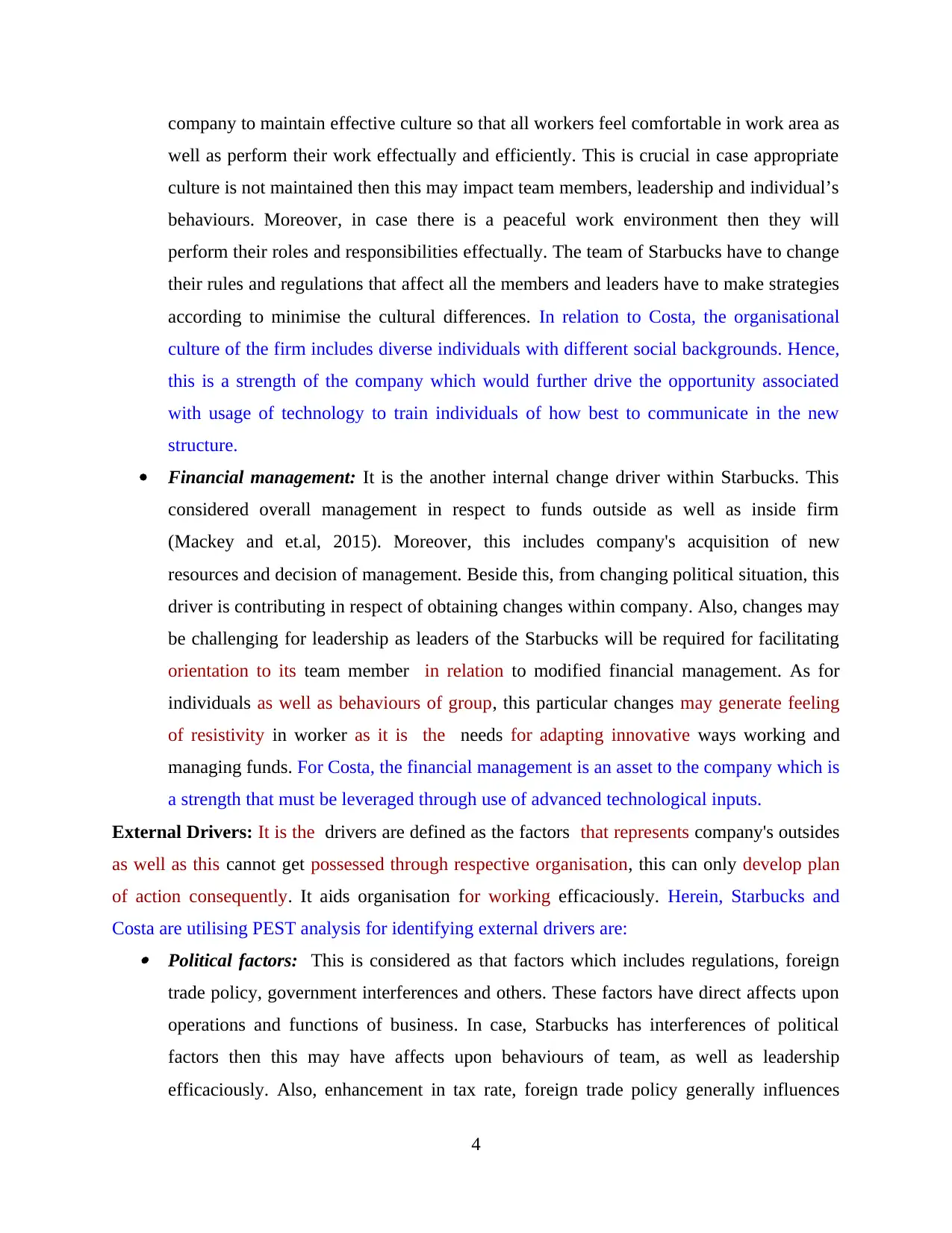
company to maintain effective culture so that all workers feel comfortable in work area as
well as perform their work effectually and efficiently. This is crucial in case appropriate
culture is not maintained then this may impact team members, leadership and individual’s
behaviours. Moreover, in case there is a peaceful work environment then they will
perform their roles and responsibilities effectually. The team of Starbucks have to change
their rules and regulations that affect all the members and leaders have to make strategies
according to minimise the cultural differences. In relation to Costa, the organisational
culture of the firm includes diverse individuals with different social backgrounds. Hence,
this is a strength of the company which would further drive the opportunity associated
with usage of technology to train individuals of how best to communicate in the new
structure.
Financial management: It is the another internal change driver within Starbucks. This
considered overall management in respect to funds outside as well as inside firm
(Mackey and et.al, 2015). Moreover, this includes company's acquisition of new
resources and decision of management. Beside this, from changing political situation, this
driver is contributing in respect of obtaining changes within company. Also, changes may
be challenging for leadership as leaders of the Starbucks will be required for facilitating
orientation to its team member in relation to modified financial management. As for
individuals as well as behaviours of group, this particular changes may generate feeling
of resistivity in worker as it is the needs for adapting innovative ways working and
managing funds. For Costa, the financial management is an asset to the company which is
a strength that must be leveraged through use of advanced technological inputs.
External Drivers: It is the drivers are defined as the factors that represents company's outsides
as well as this cannot get possessed through respective organisation, this can only develop plan
of action consequently. It aids organisation for working efficaciously. Herein, Starbucks and
Costa are utilising PEST analysis for identifying external drivers are: Political factors: This is considered as that factors which includes regulations, foreign
trade policy, government interferences and others. These factors have direct affects upon
operations and functions of business. In case, Starbucks has interferences of political
factors then this may have affects upon behaviours of team, as well as leadership
efficaciously. Also, enhancement in tax rate, foreign trade policy generally influences
4
well as perform their work effectually and efficiently. This is crucial in case appropriate
culture is not maintained then this may impact team members, leadership and individual’s
behaviours. Moreover, in case there is a peaceful work environment then they will
perform their roles and responsibilities effectually. The team of Starbucks have to change
their rules and regulations that affect all the members and leaders have to make strategies
according to minimise the cultural differences. In relation to Costa, the organisational
culture of the firm includes diverse individuals with different social backgrounds. Hence,
this is a strength of the company which would further drive the opportunity associated
with usage of technology to train individuals of how best to communicate in the new
structure.
Financial management: It is the another internal change driver within Starbucks. This
considered overall management in respect to funds outside as well as inside firm
(Mackey and et.al, 2015). Moreover, this includes company's acquisition of new
resources and decision of management. Beside this, from changing political situation, this
driver is contributing in respect of obtaining changes within company. Also, changes may
be challenging for leadership as leaders of the Starbucks will be required for facilitating
orientation to its team member in relation to modified financial management. As for
individuals as well as behaviours of group, this particular changes may generate feeling
of resistivity in worker as it is the needs for adapting innovative ways working and
managing funds. For Costa, the financial management is an asset to the company which is
a strength that must be leveraged through use of advanced technological inputs.
External Drivers: It is the drivers are defined as the factors that represents company's outsides
as well as this cannot get possessed through respective organisation, this can only develop plan
of action consequently. It aids organisation for working efficaciously. Herein, Starbucks and
Costa are utilising PEST analysis for identifying external drivers are: Political factors: This is considered as that factors which includes regulations, foreign
trade policy, government interferences and others. These factors have direct affects upon
operations and functions of business. In case, Starbucks has interferences of political
factors then this may have affects upon behaviours of team, as well as leadership
efficaciously. Also, enhancement in tax rate, foreign trade policy generally influences
4
Paraphrase This Document
Need a fresh take? Get an instant paraphrase of this document with our AI Paraphraser
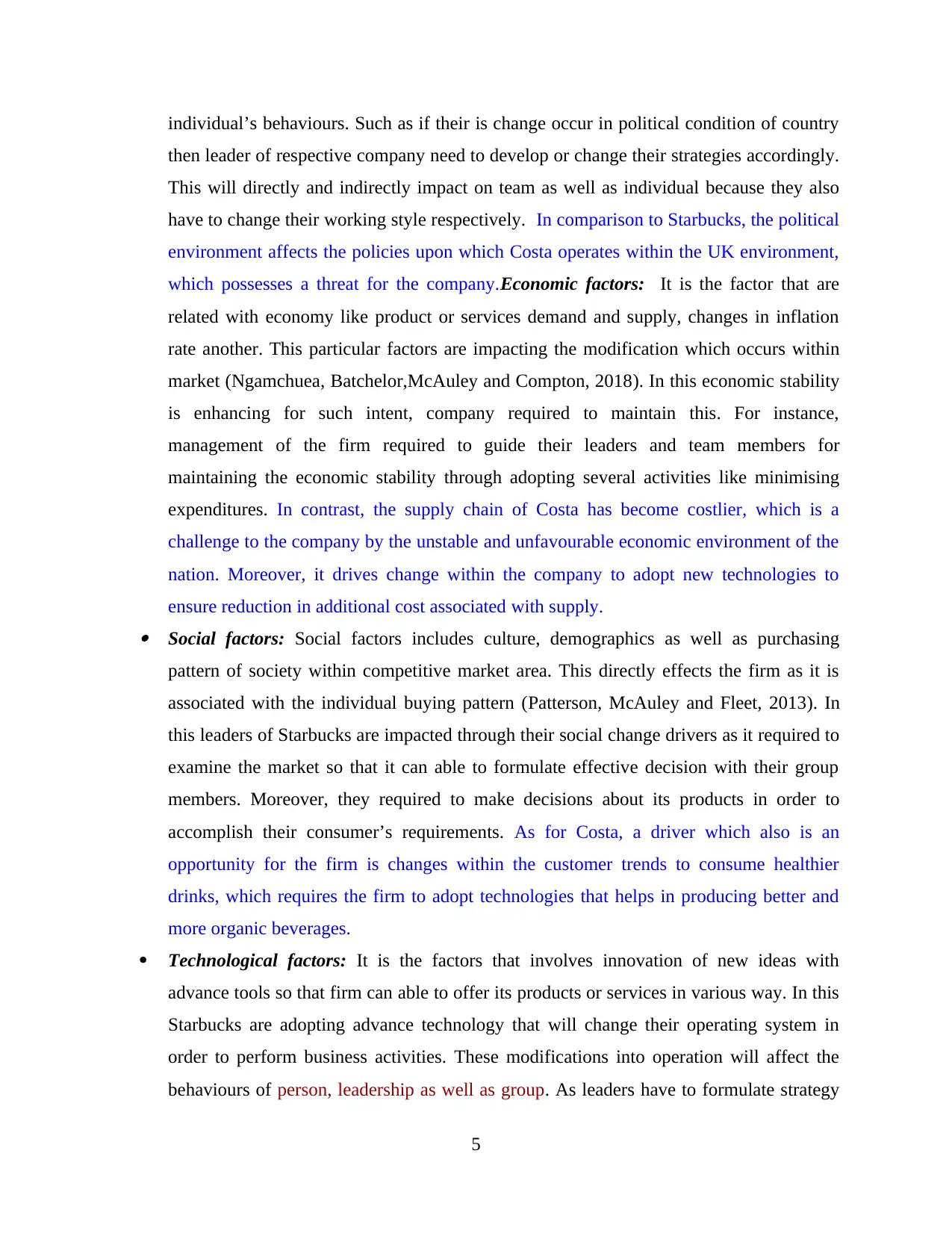
individual’s behaviours. Such as if their is change occur in political condition of country
then leader of respective company need to develop or change their strategies accordingly.
This will directly and indirectly impact on team as well as individual because they also
have to change their working style respectively. In comparison to Starbucks, the political
environment affects the policies upon which Costa operates within the UK environment,
which possesses a threat for the company.Economic factors: It is the factor that are
related with economy like product or services demand and supply, changes in inflation
rate another. This particular factors are impacting the modification which occurs within
market (Ngamchuea, Batchelor,McAuley and Compton, 2018). In this economic stability
is enhancing for such intent, company required to maintain this. For instance,
management of the firm required to guide their leaders and team members for
maintaining the economic stability through adopting several activities like minimising
expenditures. In contrast, the supply chain of Costa has become costlier, which is a
challenge to the company by the unstable and unfavourable economic environment of the
nation. Moreover, it drives change within the company to adopt new technologies to
ensure reduction in additional cost associated with supply. Social factors: Social factors includes culture, demographics as well as purchasing
pattern of society within competitive market area. This directly effects the firm as it is
associated with the individual buying pattern (Patterson, McAuley and Fleet, 2013). In
this leaders of Starbucks are impacted through their social change drivers as it required to
examine the market so that it can able to formulate effective decision with their group
members. Moreover, they required to make decisions about its products in order to
accomplish their consumer’s requirements. As for Costa, a driver which also is an
opportunity for the firm is changes within the customer trends to consume healthier
drinks, which requires the firm to adopt technologies that helps in producing better and
more organic beverages.
Technological factors: It is the factors that involves innovation of new ideas with
advance tools so that firm can able to offer its products or services in various way. In this
Starbucks are adopting advance technology that will change their operating system in
order to perform business activities. These modifications into operation will affect the
behaviours of person, leadership as well as group. As leaders have to formulate strategy
5
then leader of respective company need to develop or change their strategies accordingly.
This will directly and indirectly impact on team as well as individual because they also
have to change their working style respectively. In comparison to Starbucks, the political
environment affects the policies upon which Costa operates within the UK environment,
which possesses a threat for the company.Economic factors: It is the factor that are
related with economy like product or services demand and supply, changes in inflation
rate another. This particular factors are impacting the modification which occurs within
market (Ngamchuea, Batchelor,McAuley and Compton, 2018). In this economic stability
is enhancing for such intent, company required to maintain this. For instance,
management of the firm required to guide their leaders and team members for
maintaining the economic stability through adopting several activities like minimising
expenditures. In contrast, the supply chain of Costa has become costlier, which is a
challenge to the company by the unstable and unfavourable economic environment of the
nation. Moreover, it drives change within the company to adopt new technologies to
ensure reduction in additional cost associated with supply. Social factors: Social factors includes culture, demographics as well as purchasing
pattern of society within competitive market area. This directly effects the firm as it is
associated with the individual buying pattern (Patterson, McAuley and Fleet, 2013). In
this leaders of Starbucks are impacted through their social change drivers as it required to
examine the market so that it can able to formulate effective decision with their group
members. Moreover, they required to make decisions about its products in order to
accomplish their consumer’s requirements. As for Costa, a driver which also is an
opportunity for the firm is changes within the customer trends to consume healthier
drinks, which requires the firm to adopt technologies that helps in producing better and
more organic beverages.
Technological factors: It is the factors that involves innovation of new ideas with
advance tools so that firm can able to offer its products or services in various way. In this
Starbucks are adopting advance technology that will change their operating system in
order to perform business activities. These modifications into operation will affect the
behaviours of person, leadership as well as group. As leaders have to formulate strategy
5

and lead team according to the adoption of changes. Also, each member of the team have
to work as per the changing strategies. For Costa, this driver has different impact on its
operations and is solely associated with the manufacturing and supply functions, with
technologies such as AI and automation. This acts as an opportunity for this company to
ensure adoption of new technologies to enhance the functioning of the company.
P3
Starbucks is an organisation which is one of the most appropriate and effective
companies when it comes to serving customers and ensuring perfect operations and functions.
Currently, the firm is facing a change within its organisational structure that has been shifted to a
flat one. Hence, with each change, several barriers also arise which are necessary to be mitigated
through application of certain approaches. These measures can aid firm in adopting procedures
as well as techniques to protect itself for whole negative impacts of modification. So, In order to
decrease the negative affects, Starbucks can use change management that is PDCA framework
for enhancing the optimistic impact of changes as well as reduce the negative effect. PDCA
Model is defined as the iterative method for continuous improvement procedures, products or
services as well as is a key component of lean management. It is also called the Deming wheel
which was established in year 1950s through William deming as a improvement procedures.
Moreover, this facilitates a easy as well as efficacious approach for resolving issues and
managing changes. This allows businesses to improve hypotheses regarding what required to be
change, test these hypotheses in ongoing feedback loop as well as gain valuable knowledge and
learning. Also, this promotes testing improvements upon small scale before updating firm wide
working methods as well as process. This model is discussed below:
6
I
llustration 1: PDCA Model
(Source: PDCA Model,2019)
to work as per the changing strategies. For Costa, this driver has different impact on its
operations and is solely associated with the manufacturing and supply functions, with
technologies such as AI and automation. This acts as an opportunity for this company to
ensure adoption of new technologies to enhance the functioning of the company.
P3
Starbucks is an organisation which is one of the most appropriate and effective
companies when it comes to serving customers and ensuring perfect operations and functions.
Currently, the firm is facing a change within its organisational structure that has been shifted to a
flat one. Hence, with each change, several barriers also arise which are necessary to be mitigated
through application of certain approaches. These measures can aid firm in adopting procedures
as well as techniques to protect itself for whole negative impacts of modification. So, In order to
decrease the negative affects, Starbucks can use change management that is PDCA framework
for enhancing the optimistic impact of changes as well as reduce the negative effect. PDCA
Model is defined as the iterative method for continuous improvement procedures, products or
services as well as is a key component of lean management. It is also called the Deming wheel
which was established in year 1950s through William deming as a improvement procedures.
Moreover, this facilitates a easy as well as efficacious approach for resolving issues and
managing changes. This allows businesses to improve hypotheses regarding what required to be
change, test these hypotheses in ongoing feedback loop as well as gain valuable knowledge and
learning. Also, this promotes testing improvements upon small scale before updating firm wide
working methods as well as process. This model is discussed below:
6
I
llustration 1: PDCA Model
(Source: PDCA Model,2019)
You're viewing a preview
Unlock full access by subscribing today!
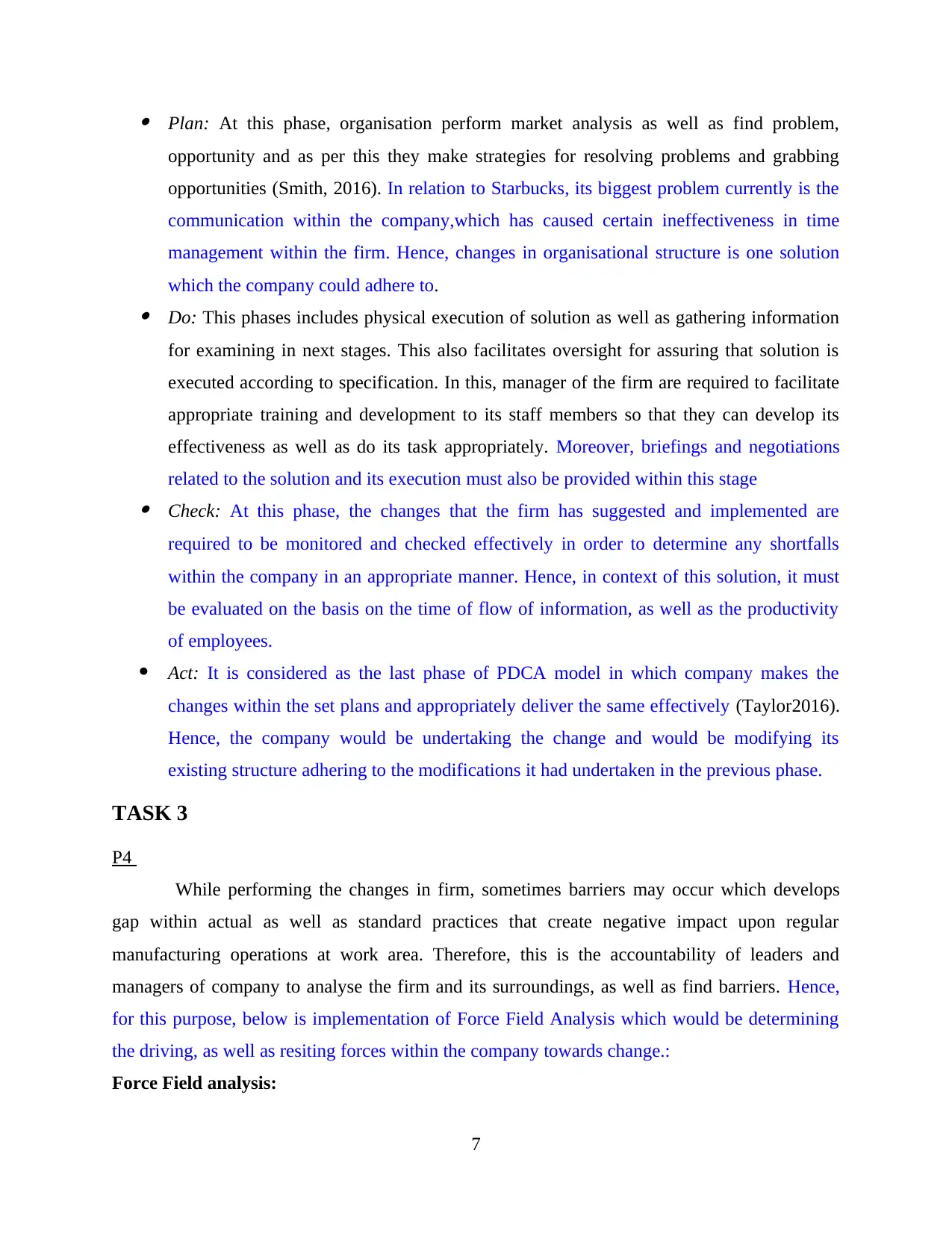
Plan: At this phase, organisation perform market analysis as well as find problem,
opportunity and as per this they make strategies for resolving problems and grabbing
opportunities (Smith, 2016). In relation to Starbucks, its biggest problem currently is the
communication within the company,which has caused certain ineffectiveness in time
management within the firm. Hence, changes in organisational structure is one solution
which the company could adhere to. Do: This phases includes physical execution of solution as well as gathering information
for examining in next stages. This also facilitates oversight for assuring that solution is
executed according to specification. In this, manager of the firm are required to facilitate
appropriate training and development to its staff members so that they can develop its
effectiveness as well as do its task appropriately. Moreover, briefings and negotiations
related to the solution and its execution must also be provided within this stage Check: At this phase, the changes that the firm has suggested and implemented are
required to be monitored and checked effectively in order to determine any shortfalls
within the company in an appropriate manner. Hence, in context of this solution, it must
be evaluated on the basis on the time of flow of information, as well as the productivity
of employees.
Act: It is considered as the last phase of PDCA model in which company makes the
changes within the set plans and appropriately deliver the same effectively (Taylor2016).
Hence, the company would be undertaking the change and would be modifying its
existing structure adhering to the modifications it had undertaken in the previous phase.
TASK 3
P4
While performing the changes in firm, sometimes barriers may occur which develops
gap within actual as well as standard practices that create negative impact upon regular
manufacturing operations at work area. Therefore, this is the accountability of leaders and
managers of company to analyse the firm and its surroundings, as well as find barriers. Hence,
for this purpose, below is implementation of Force Field Analysis which would be determining
the driving, as well as resiting forces within the company towards change.:
Force Field analysis:
7
opportunity and as per this they make strategies for resolving problems and grabbing
opportunities (Smith, 2016). In relation to Starbucks, its biggest problem currently is the
communication within the company,which has caused certain ineffectiveness in time
management within the firm. Hence, changes in organisational structure is one solution
which the company could adhere to. Do: This phases includes physical execution of solution as well as gathering information
for examining in next stages. This also facilitates oversight for assuring that solution is
executed according to specification. In this, manager of the firm are required to facilitate
appropriate training and development to its staff members so that they can develop its
effectiveness as well as do its task appropriately. Moreover, briefings and negotiations
related to the solution and its execution must also be provided within this stage Check: At this phase, the changes that the firm has suggested and implemented are
required to be monitored and checked effectively in order to determine any shortfalls
within the company in an appropriate manner. Hence, in context of this solution, it must
be evaluated on the basis on the time of flow of information, as well as the productivity
of employees.
Act: It is considered as the last phase of PDCA model in which company makes the
changes within the set plans and appropriately deliver the same effectively (Taylor2016).
Hence, the company would be undertaking the change and would be modifying its
existing structure adhering to the modifications it had undertaken in the previous phase.
TASK 3
P4
While performing the changes in firm, sometimes barriers may occur which develops
gap within actual as well as standard practices that create negative impact upon regular
manufacturing operations at work area. Therefore, this is the accountability of leaders and
managers of company to analyse the firm and its surroundings, as well as find barriers. Hence,
for this purpose, below is implementation of Force Field Analysis which would be determining
the driving, as well as resiting forces within the company towards change.:
Force Field analysis:
7
Paraphrase This Document
Need a fresh take? Get an instant paraphrase of this document with our AI Paraphraser
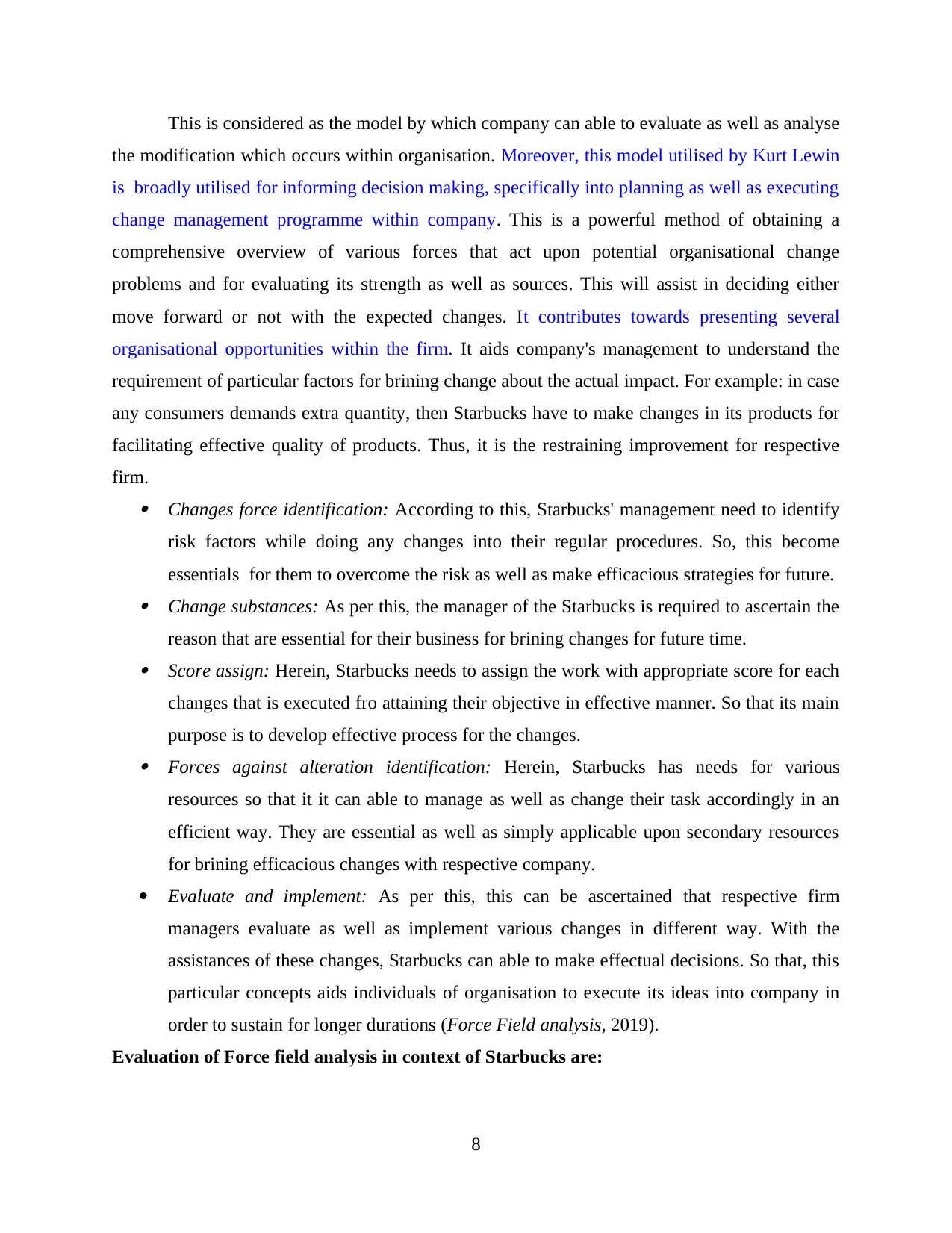
This is considered as the model by which company can able to evaluate as well as analyse
the modification which occurs within organisation. Moreover, this model utilised by Kurt Lewin
is broadly utilised for informing decision making, specifically into planning as well as executing
change management programme within company. This is a powerful method of obtaining a
comprehensive overview of various forces that act upon potential organisational change
problems and for evaluating its strength as well as sources. This will assist in deciding either
move forward or not with the expected changes. It contributes towards presenting several
organisational opportunities within the firm. It aids company's management to understand the
requirement of particular factors for brining change about the actual impact. For example: in case
any consumers demands extra quantity, then Starbucks have to make changes in its products for
facilitating effective quality of products. Thus, it is the restraining improvement for respective
firm. Changes force identification: According to this, Starbucks' management need to identify
risk factors while doing any changes into their regular procedures. So, this become
essentials for them to overcome the risk as well as make efficacious strategies for future. Change substances: As per this, the manager of the Starbucks is required to ascertain the
reason that are essential for their business for brining changes for future time. Score assign: Herein, Starbucks needs to assign the work with appropriate score for each
changes that is executed fro attaining their objective in effective manner. So that its main
purpose is to develop effective process for the changes. Forces against alteration identification: Herein, Starbucks has needs for various
resources so that it it can able to manage as well as change their task accordingly in an
efficient way. They are essential as well as simply applicable upon secondary resources
for brining efficacious changes with respective company.
Evaluate and implement: As per this, this can be ascertained that respective firm
managers evaluate as well as implement various changes in different way. With the
assistances of these changes, Starbucks can able to make effectual decisions. So that, this
particular concepts aids individuals of organisation to execute its ideas into company in
order to sustain for longer durations (Force Field analysis, 2019).
Evaluation of Force field analysis in context of Starbucks are:
8
the modification which occurs within organisation. Moreover, this model utilised by Kurt Lewin
is broadly utilised for informing decision making, specifically into planning as well as executing
change management programme within company. This is a powerful method of obtaining a
comprehensive overview of various forces that act upon potential organisational change
problems and for evaluating its strength as well as sources. This will assist in deciding either
move forward or not with the expected changes. It contributes towards presenting several
organisational opportunities within the firm. It aids company's management to understand the
requirement of particular factors for brining change about the actual impact. For example: in case
any consumers demands extra quantity, then Starbucks have to make changes in its products for
facilitating effective quality of products. Thus, it is the restraining improvement for respective
firm. Changes force identification: According to this, Starbucks' management need to identify
risk factors while doing any changes into their regular procedures. So, this become
essentials for them to overcome the risk as well as make efficacious strategies for future. Change substances: As per this, the manager of the Starbucks is required to ascertain the
reason that are essential for their business for brining changes for future time. Score assign: Herein, Starbucks needs to assign the work with appropriate score for each
changes that is executed fro attaining their objective in effective manner. So that its main
purpose is to develop effective process for the changes. Forces against alteration identification: Herein, Starbucks has needs for various
resources so that it it can able to manage as well as change their task accordingly in an
efficient way. They are essential as well as simply applicable upon secondary resources
for brining efficacious changes with respective company.
Evaluate and implement: As per this, this can be ascertained that respective firm
managers evaluate as well as implement various changes in different way. With the
assistances of these changes, Starbucks can able to make effectual decisions. So that, this
particular concepts aids individuals of organisation to execute its ideas into company in
order to sustain for longer durations (Force Field analysis, 2019).
Evaluation of Force field analysis in context of Starbucks are:
8
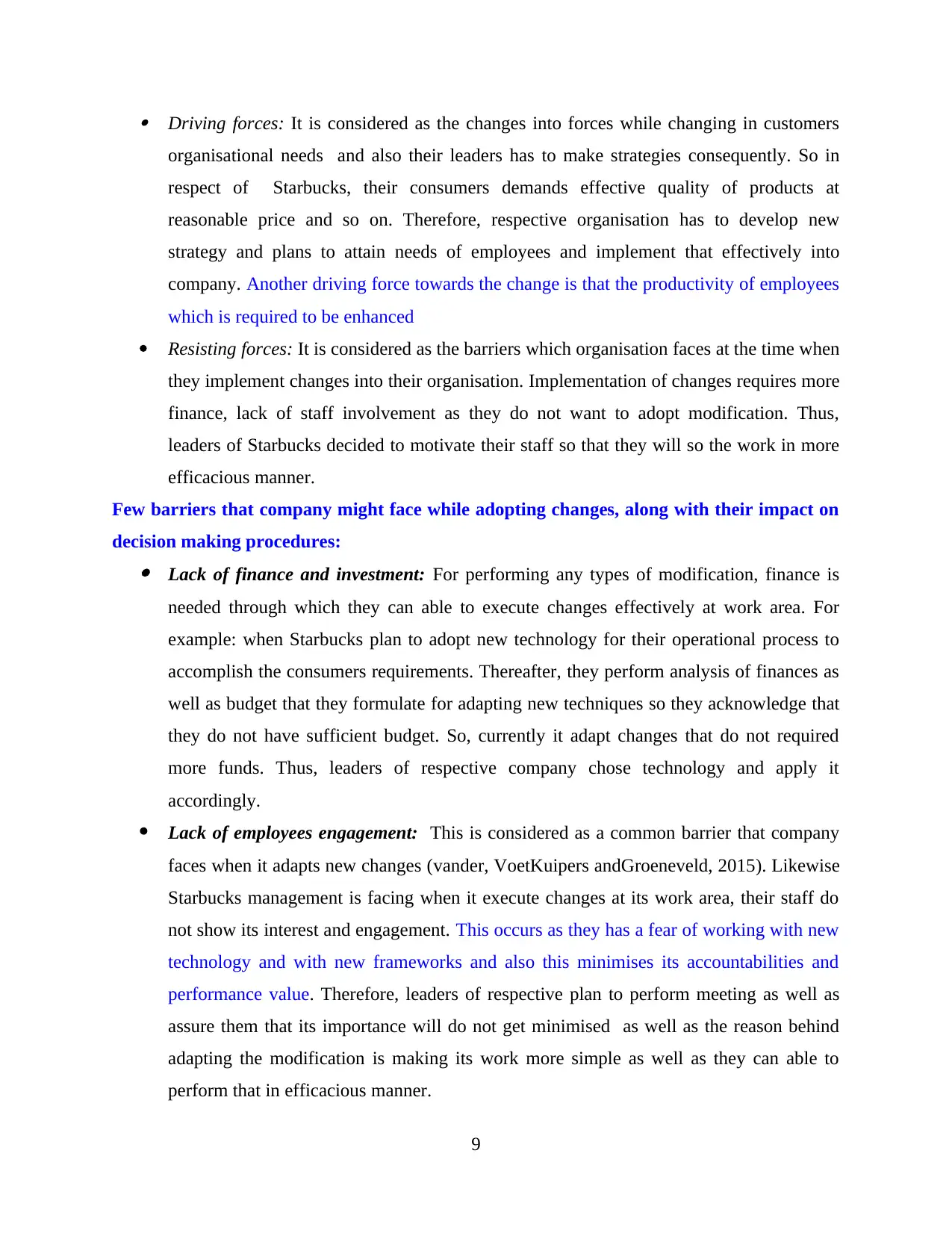
Driving forces: It is considered as the changes into forces while changing in customers
organisational needs and also their leaders has to make strategies consequently. So in
respect of Starbucks, their consumers demands effective quality of products at
reasonable price and so on. Therefore, respective organisation has to develop new
strategy and plans to attain needs of employees and implement that effectively into
company. Another driving force towards the change is that the productivity of employees
which is required to be enhanced
Resisting forces: It is considered as the barriers which organisation faces at the time when
they implement changes into their organisation. Implementation of changes requires more
finance, lack of staff involvement as they do not want to adopt modification. Thus,
leaders of Starbucks decided to motivate their staff so that they will so the work in more
efficacious manner.
Few barriers that company might face while adopting changes, along with their impact on
decision making procedures: Lack of finance and investment: For performing any types of modification, finance is
needed through which they can able to execute changes effectively at work area. For
example: when Starbucks plan to adopt new technology for their operational process to
accomplish the consumers requirements. Thereafter, they perform analysis of finances as
well as budget that they formulate for adapting new techniques so they acknowledge that
they do not have sufficient budget. So, currently it adapt changes that do not required
more funds. Thus, leaders of respective company chose technology and apply it
accordingly.
Lack of employees engagement: This is considered as a common barrier that company
faces when it adapts new changes (vander, VoetKuipers andGroeneveld, 2015). Likewise
Starbucks management is facing when it execute changes at its work area, their staff do
not show its interest and engagement. This occurs as they has a fear of working with new
technology and with new frameworks and also this minimises its accountabilities and
performance value. Therefore, leaders of respective plan to perform meeting as well as
assure them that its importance will do not get minimised as well as the reason behind
adapting the modification is making its work more simple as well as they can able to
perform that in efficacious manner.
9
organisational needs and also their leaders has to make strategies consequently. So in
respect of Starbucks, their consumers demands effective quality of products at
reasonable price and so on. Therefore, respective organisation has to develop new
strategy and plans to attain needs of employees and implement that effectively into
company. Another driving force towards the change is that the productivity of employees
which is required to be enhanced
Resisting forces: It is considered as the barriers which organisation faces at the time when
they implement changes into their organisation. Implementation of changes requires more
finance, lack of staff involvement as they do not want to adopt modification. Thus,
leaders of Starbucks decided to motivate their staff so that they will so the work in more
efficacious manner.
Few barriers that company might face while adopting changes, along with their impact on
decision making procedures: Lack of finance and investment: For performing any types of modification, finance is
needed through which they can able to execute changes effectively at work area. For
example: when Starbucks plan to adopt new technology for their operational process to
accomplish the consumers requirements. Thereafter, they perform analysis of finances as
well as budget that they formulate for adapting new techniques so they acknowledge that
they do not have sufficient budget. So, currently it adapt changes that do not required
more funds. Thus, leaders of respective company chose technology and apply it
accordingly.
Lack of employees engagement: This is considered as a common barrier that company
faces when it adapts new changes (vander, VoetKuipers andGroeneveld, 2015). Likewise
Starbucks management is facing when it execute changes at its work area, their staff do
not show its interest and engagement. This occurs as they has a fear of working with new
technology and with new frameworks and also this minimises its accountabilities and
performance value. Therefore, leaders of respective plan to perform meeting as well as
assure them that its importance will do not get minimised as well as the reason behind
adapting the modification is making its work more simple as well as they can able to
perform that in efficacious manner.
9
You're viewing a preview
Unlock full access by subscribing today!
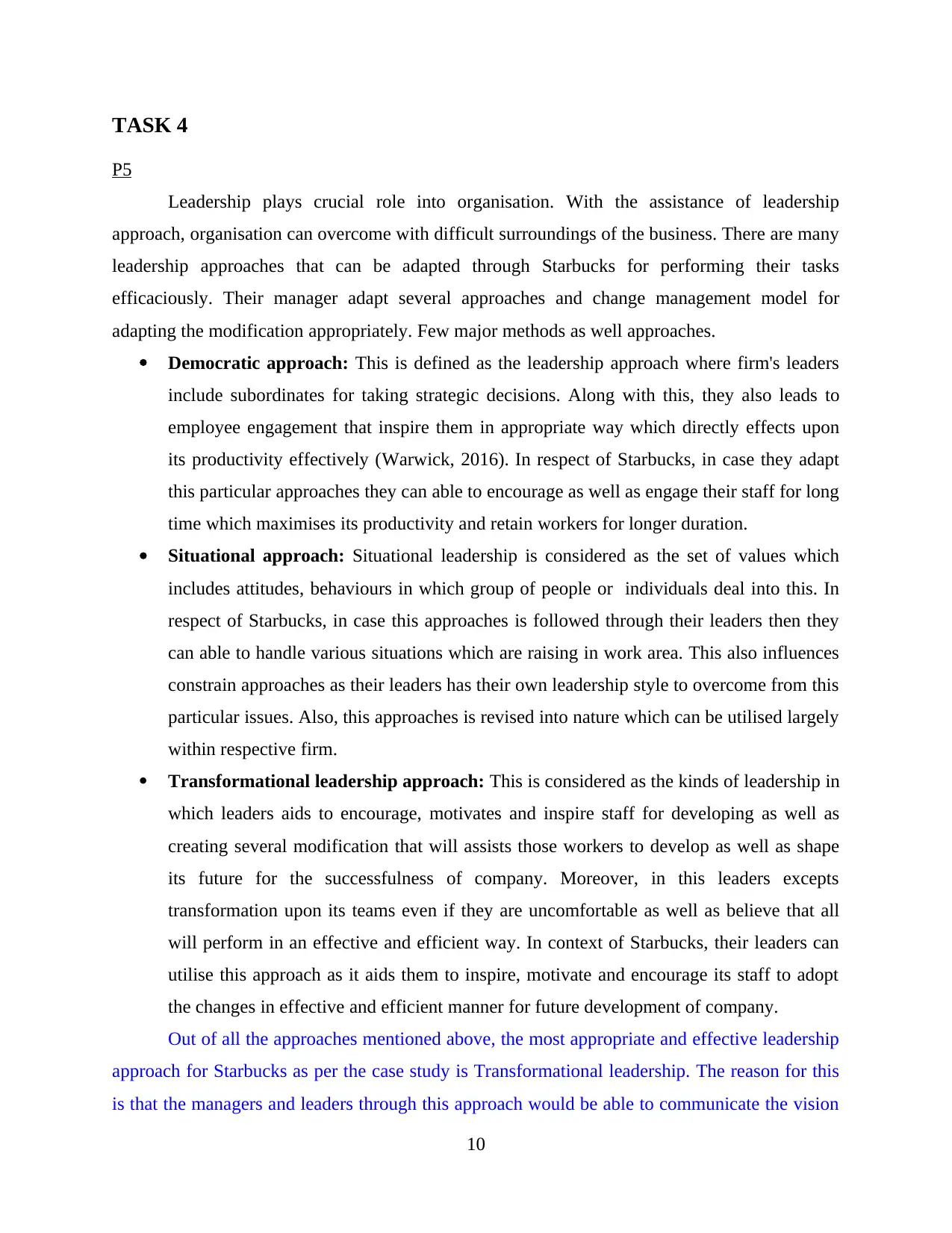
TASK 4
P5
Leadership plays crucial role into organisation. With the assistance of leadership
approach, organisation can overcome with difficult surroundings of the business. There are many
leadership approaches that can be adapted through Starbucks for performing their tasks
efficaciously. Their manager adapt several approaches and change management model for
adapting the modification appropriately. Few major methods as well approaches.
Democratic approach: This is defined as the leadership approach where firm's leaders
include subordinates for taking strategic decisions. Along with this, they also leads to
employee engagement that inspire them in appropriate way which directly effects upon
its productivity effectively (Warwick, 2016). In respect of Starbucks, in case they adapt
this particular approaches they can able to encourage as well as engage their staff for long
time which maximises its productivity and retain workers for longer duration.
Situational approach: Situational leadership is considered as the set of values which
includes attitudes, behaviours in which group of people or individuals deal into this. In
respect of Starbucks, in case this approaches is followed through their leaders then they
can able to handle various situations which are raising in work area. This also influences
constrain approaches as their leaders has their own leadership style to overcome from this
particular issues. Also, this approaches is revised into nature which can be utilised largely
within respective firm.
Transformational leadership approach: This is considered as the kinds of leadership in
which leaders aids to encourage, motivates and inspire staff for developing as well as
creating several modification that will assists those workers to develop as well as shape
its future for the successfulness of company. Moreover, in this leaders excepts
transformation upon its teams even if they are uncomfortable as well as believe that all
will perform in an effective and efficient way. In context of Starbucks, their leaders can
utilise this approach as it aids them to inspire, motivate and encourage its staff to adopt
the changes in effective and efficient manner for future development of company.
Out of all the approaches mentioned above, the most appropriate and effective leadership
approach for Starbucks as per the case study is Transformational leadership. The reason for this
is that the managers and leaders through this approach would be able to communicate the vision
10
P5
Leadership plays crucial role into organisation. With the assistance of leadership
approach, organisation can overcome with difficult surroundings of the business. There are many
leadership approaches that can be adapted through Starbucks for performing their tasks
efficaciously. Their manager adapt several approaches and change management model for
adapting the modification appropriately. Few major methods as well approaches.
Democratic approach: This is defined as the leadership approach where firm's leaders
include subordinates for taking strategic decisions. Along with this, they also leads to
employee engagement that inspire them in appropriate way which directly effects upon
its productivity effectively (Warwick, 2016). In respect of Starbucks, in case they adapt
this particular approaches they can able to encourage as well as engage their staff for long
time which maximises its productivity and retain workers for longer duration.
Situational approach: Situational leadership is considered as the set of values which
includes attitudes, behaviours in which group of people or individuals deal into this. In
respect of Starbucks, in case this approaches is followed through their leaders then they
can able to handle various situations which are raising in work area. This also influences
constrain approaches as their leaders has their own leadership style to overcome from this
particular issues. Also, this approaches is revised into nature which can be utilised largely
within respective firm.
Transformational leadership approach: This is considered as the kinds of leadership in
which leaders aids to encourage, motivates and inspire staff for developing as well as
creating several modification that will assists those workers to develop as well as shape
its future for the successfulness of company. Moreover, in this leaders excepts
transformation upon its teams even if they are uncomfortable as well as believe that all
will perform in an effective and efficient way. In context of Starbucks, their leaders can
utilise this approach as it aids them to inspire, motivate and encourage its staff to adopt
the changes in effective and efficient manner for future development of company.
Out of all the approaches mentioned above, the most appropriate and effective leadership
approach for Starbucks as per the case study is Transformational leadership. The reason for this
is that the managers and leaders through this approach would be able to communicate the vision
10
Paraphrase This Document
Need a fresh take? Get an instant paraphrase of this document with our AI Paraphraser
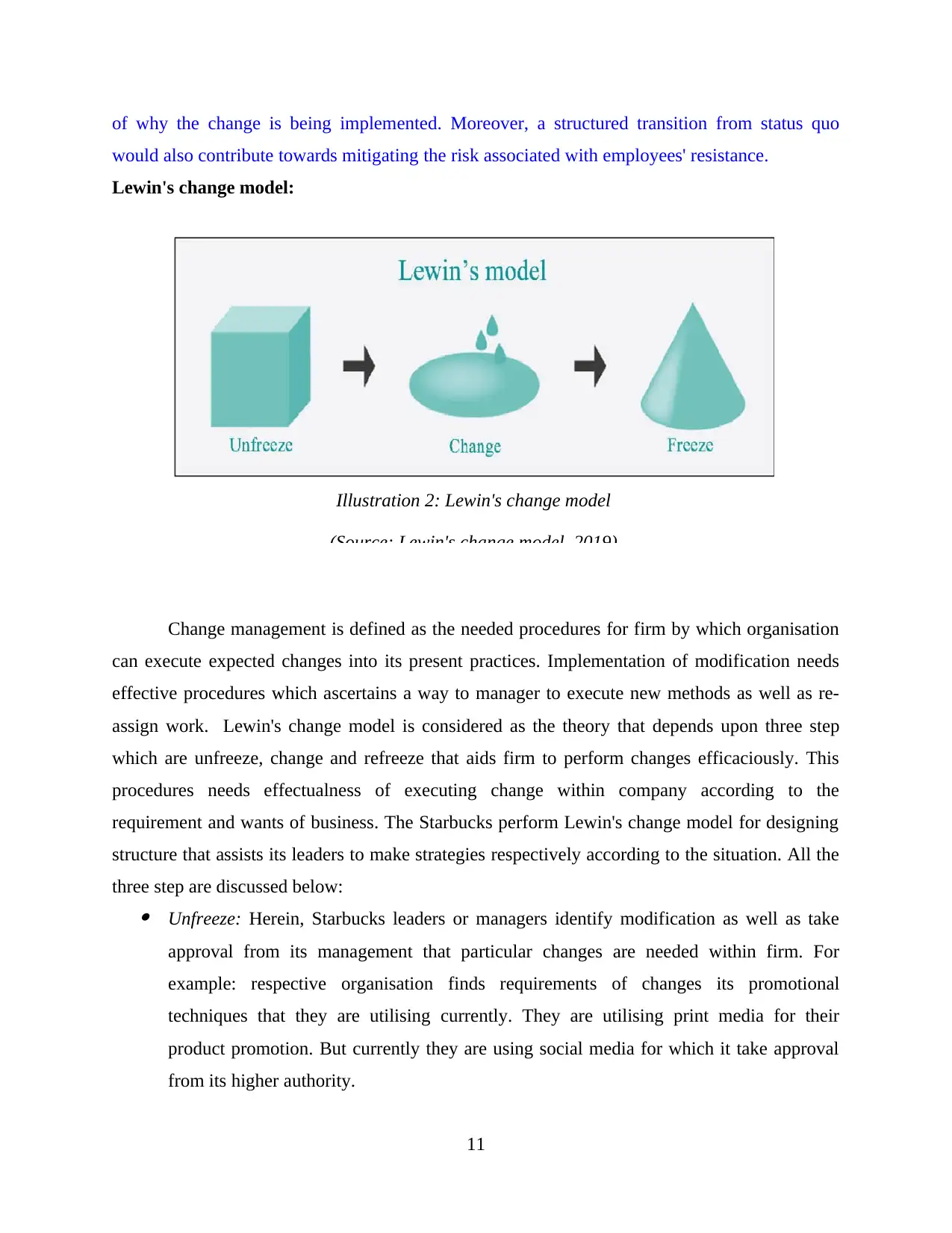
of why the change is being implemented. Moreover, a structured transition from status quo
would also contribute towards mitigating the risk associated with employees' resistance.
Lewin's change model:
Change management is defined as the needed procedures for firm by which organisation
can execute expected changes into its present practices. Implementation of modification needs
effective procedures which ascertains a way to manager to execute new methods as well as re-
assign work. Lewin's change model is considered as the theory that depends upon three step
which are unfreeze, change and refreeze that aids firm to perform changes efficaciously. This
procedures needs effectualness of executing change within company according to the
requirement and wants of business. The Starbucks perform Lewin's change model for designing
structure that assists its leaders to make strategies respectively according to the situation. All the
three step are discussed below: Unfreeze: Herein, Starbucks leaders or managers identify modification as well as take
approval from its management that particular changes are needed within firm. For
example: respective organisation finds requirements of changes its promotional
techniques that they are utilising currently. They are utilising print media for their
product promotion. But currently they are using social media for which it take approval
from its higher authority.
11
Illustration 2: Lewin's change model
(Source: Lewin's change model. 2019)
would also contribute towards mitigating the risk associated with employees' resistance.
Lewin's change model:
Change management is defined as the needed procedures for firm by which organisation
can execute expected changes into its present practices. Implementation of modification needs
effective procedures which ascertains a way to manager to execute new methods as well as re-
assign work. Lewin's change model is considered as the theory that depends upon three step
which are unfreeze, change and refreeze that aids firm to perform changes efficaciously. This
procedures needs effectualness of executing change within company according to the
requirement and wants of business. The Starbucks perform Lewin's change model for designing
structure that assists its leaders to make strategies respectively according to the situation. All the
three step are discussed below: Unfreeze: Herein, Starbucks leaders or managers identify modification as well as take
approval from its management that particular changes are needed within firm. For
example: respective organisation finds requirements of changes its promotional
techniques that they are utilising currently. They are utilising print media for their
product promotion. But currently they are using social media for which it take approval
from its higher authority.
11
Illustration 2: Lewin's change model
(Source: Lewin's change model. 2019)
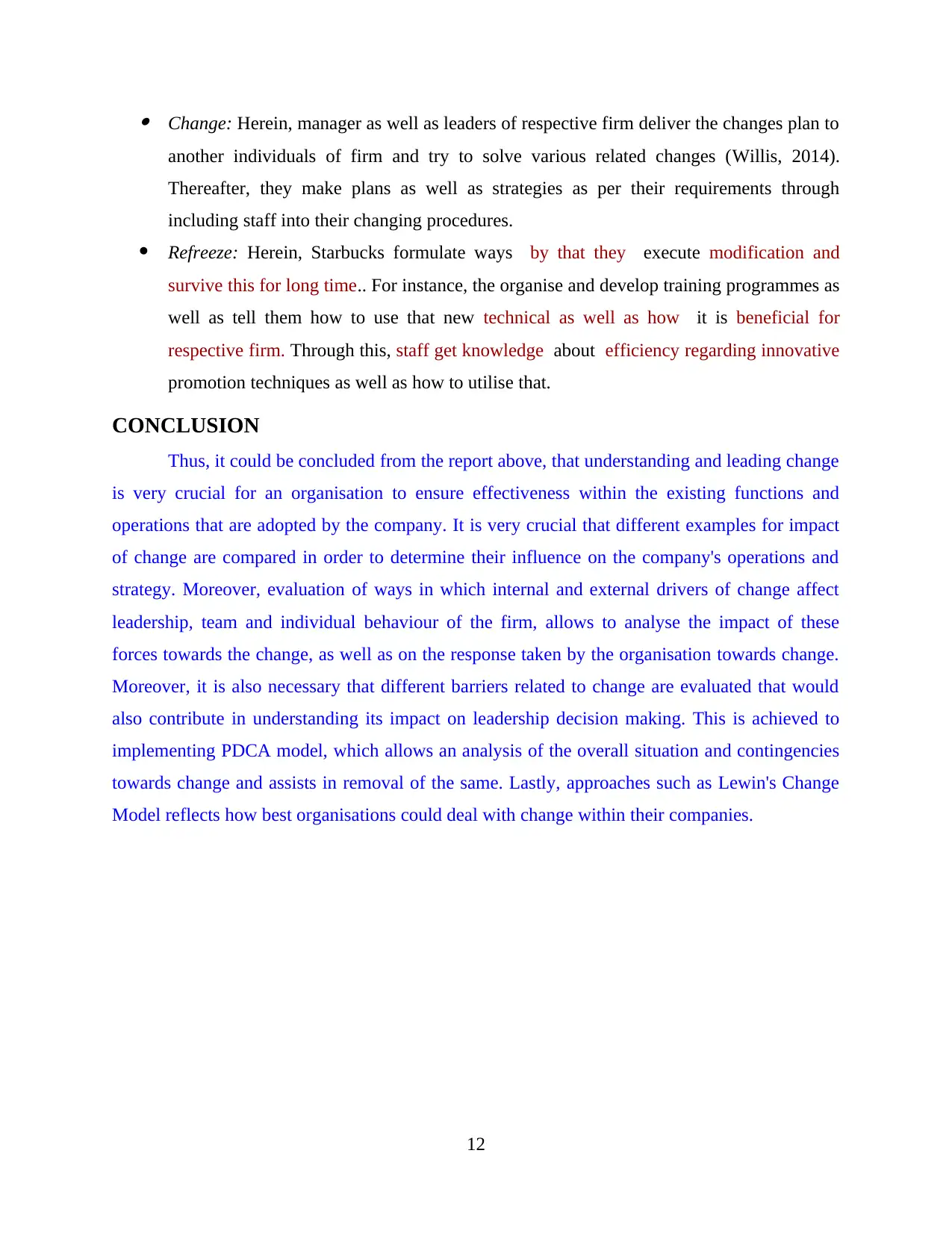
Change: Herein, manager as well as leaders of respective firm deliver the changes plan to
another individuals of firm and try to solve various related changes (Willis, 2014).
Thereafter, they make plans as well as strategies as per their requirements through
including staff into their changing procedures.
Refreeze: Herein, Starbucks formulate ways by that they execute modification and
survive this for long time.. For instance, the organise and develop training programmes as
well as tell them how to use that new technical as well as how it is beneficial for
respective firm. Through this, staff get knowledge about efficiency regarding innovative
promotion techniques as well as how to utilise that.
CONCLUSION
Thus, it could be concluded from the report above, that understanding and leading change
is very crucial for an organisation to ensure effectiveness within the existing functions and
operations that are adopted by the company. It is very crucial that different examples for impact
of change are compared in order to determine their influence on the company's operations and
strategy. Moreover, evaluation of ways in which internal and external drivers of change affect
leadership, team and individual behaviour of the firm, allows to analyse the impact of these
forces towards the change, as well as on the response taken by the organisation towards change.
Moreover, it is also necessary that different barriers related to change are evaluated that would
also contribute in understanding its impact on leadership decision making. This is achieved to
implementing PDCA model, which allows an analysis of the overall situation and contingencies
towards change and assists in removal of the same. Lastly, approaches such as Lewin's Change
Model reflects how best organisations could deal with change within their companies.
12
another individuals of firm and try to solve various related changes (Willis, 2014).
Thereafter, they make plans as well as strategies as per their requirements through
including staff into their changing procedures.
Refreeze: Herein, Starbucks formulate ways by that they execute modification and
survive this for long time.. For instance, the organise and develop training programmes as
well as tell them how to use that new technical as well as how it is beneficial for
respective firm. Through this, staff get knowledge about efficiency regarding innovative
promotion techniques as well as how to utilise that.
CONCLUSION
Thus, it could be concluded from the report above, that understanding and leading change
is very crucial for an organisation to ensure effectiveness within the existing functions and
operations that are adopted by the company. It is very crucial that different examples for impact
of change are compared in order to determine their influence on the company's operations and
strategy. Moreover, evaluation of ways in which internal and external drivers of change affect
leadership, team and individual behaviour of the firm, allows to analyse the impact of these
forces towards the change, as well as on the response taken by the organisation towards change.
Moreover, it is also necessary that different barriers related to change are evaluated that would
also contribute in understanding its impact on leadership decision making. This is achieved to
implementing PDCA model, which allows an analysis of the overall situation and contingencies
towards change and assists in removal of the same. Lastly, approaches such as Lewin's Change
Model reflects how best organisations could deal with change within their companies.
12
You're viewing a preview
Unlock full access by subscribing today!
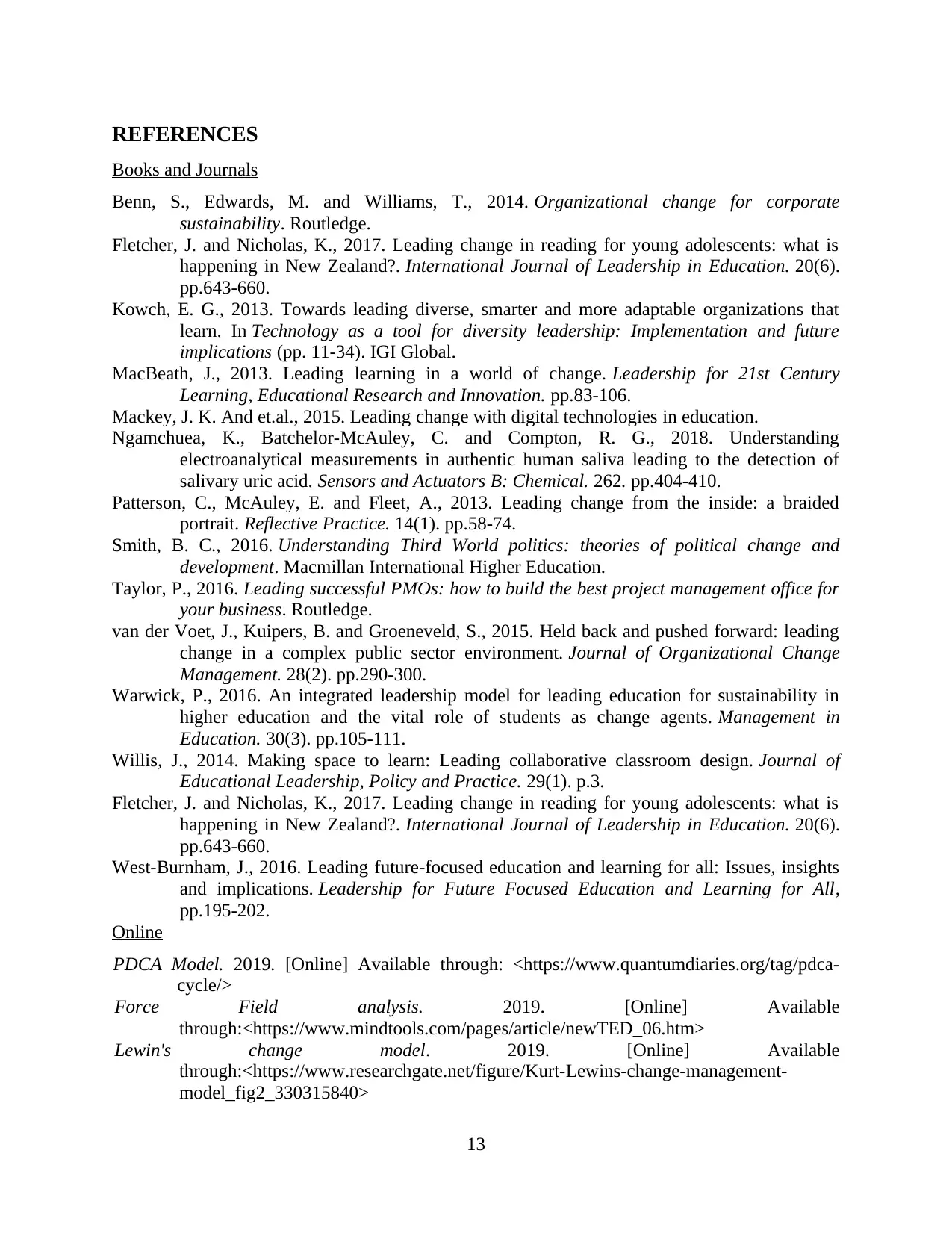
REFERENCES
Books and Journals
Benn, S., Edwards, M. and Williams, T., 2014. Organizational change for corporate
sustainability. Routledge.
Fletcher, J. and Nicholas, K., 2017. Leading change in reading for young adolescents: what is
happening in New Zealand?. International Journal of Leadership in Education. 20(6).
pp.643-660.
Kowch, E. G., 2013. Towards leading diverse, smarter and more adaptable organizations that
learn. In Technology as a tool for diversity leadership: Implementation and future
implications (pp. 11-34). IGI Global.
MacBeath, J., 2013. Leading learning in a world of change. Leadership for 21st Century
Learning, Educational Research and Innovation. pp.83-106.
Mackey, J. K. And et.al., 2015. Leading change with digital technologies in education.
Ngamchuea, K., Batchelor-McAuley, C. and Compton, R. G., 2018. Understanding
electroanalytical measurements in authentic human saliva leading to the detection of
salivary uric acid. Sensors and Actuators B: Chemical. 262. pp.404-410.
Patterson, C., McAuley, E. and Fleet, A., 2013. Leading change from the inside: a braided
portrait. Reflective Practice. 14(1). pp.58-74.
Smith, B. C., 2016. Understanding Third World politics: theories of political change and
development. Macmillan International Higher Education.
Taylor, P., 2016. Leading successful PMOs: how to build the best project management office for
your business. Routledge.
van der Voet, J., Kuipers, B. and Groeneveld, S., 2015. Held back and pushed forward: leading
change in a complex public sector environment. Journal of Organizational Change
Management. 28(2). pp.290-300.
Warwick, P., 2016. An integrated leadership model for leading education for sustainability in
higher education and the vital role of students as change agents. Management in
Education. 30(3). pp.105-111.
Willis, J., 2014. Making space to learn: Leading collaborative classroom design. Journal of
Educational Leadership, Policy and Practice. 29(1). p.3.
Fletcher, J. and Nicholas, K., 2017. Leading change in reading for young adolescents: what is
happening in New Zealand?. International Journal of Leadership in Education. 20(6).
pp.643-660.
West-Burnham, J., 2016. Leading future-focused education and learning for all: Issues, insights
and implications. Leadership for Future Focused Education and Learning for All,
pp.195-202.
Online
PDCA Model. 2019. [Online] Available through: <https://www.quantumdiaries.org/tag/pdca-
cycle/>
Force Field analysis. 2019. [Online] Available
through:<https://www.mindtools.com/pages/article/newTED_06.htm>
Lewin's change model. 2019. [Online] Available
through:<https://www.researchgate.net/figure/Kurt-Lewins-change-management-
model_fig2_330315840>
13
Books and Journals
Benn, S., Edwards, M. and Williams, T., 2014. Organizational change for corporate
sustainability. Routledge.
Fletcher, J. and Nicholas, K., 2017. Leading change in reading for young adolescents: what is
happening in New Zealand?. International Journal of Leadership in Education. 20(6).
pp.643-660.
Kowch, E. G., 2013. Towards leading diverse, smarter and more adaptable organizations that
learn. In Technology as a tool for diversity leadership: Implementation and future
implications (pp. 11-34). IGI Global.
MacBeath, J., 2013. Leading learning in a world of change. Leadership for 21st Century
Learning, Educational Research and Innovation. pp.83-106.
Mackey, J. K. And et.al., 2015. Leading change with digital technologies in education.
Ngamchuea, K., Batchelor-McAuley, C. and Compton, R. G., 2018. Understanding
electroanalytical measurements in authentic human saliva leading to the detection of
salivary uric acid. Sensors and Actuators B: Chemical. 262. pp.404-410.
Patterson, C., McAuley, E. and Fleet, A., 2013. Leading change from the inside: a braided
portrait. Reflective Practice. 14(1). pp.58-74.
Smith, B. C., 2016. Understanding Third World politics: theories of political change and
development. Macmillan International Higher Education.
Taylor, P., 2016. Leading successful PMOs: how to build the best project management office for
your business. Routledge.
van der Voet, J., Kuipers, B. and Groeneveld, S., 2015. Held back and pushed forward: leading
change in a complex public sector environment. Journal of Organizational Change
Management. 28(2). pp.290-300.
Warwick, P., 2016. An integrated leadership model for leading education for sustainability in
higher education and the vital role of students as change agents. Management in
Education. 30(3). pp.105-111.
Willis, J., 2014. Making space to learn: Leading collaborative classroom design. Journal of
Educational Leadership, Policy and Practice. 29(1). p.3.
Fletcher, J. and Nicholas, K., 2017. Leading change in reading for young adolescents: what is
happening in New Zealand?. International Journal of Leadership in Education. 20(6).
pp.643-660.
West-Burnham, J., 2016. Leading future-focused education and learning for all: Issues, insights
and implications. Leadership for Future Focused Education and Learning for All,
pp.195-202.
Online
PDCA Model. 2019. [Online] Available through: <https://www.quantumdiaries.org/tag/pdca-
cycle/>
Force Field analysis. 2019. [Online] Available
through:<https://www.mindtools.com/pages/article/newTED_06.htm>
Lewin's change model. 2019. [Online] Available
through:<https://www.researchgate.net/figure/Kurt-Lewins-change-management-
model_fig2_330315840>
13
Paraphrase This Document
Need a fresh take? Get an instant paraphrase of this document with our AI Paraphraser

14
1 out of 17
Related Documents
Your All-in-One AI-Powered Toolkit for Academic Success.
+13062052269
info@desklib.com
Available 24*7 on WhatsApp / Email
![[object Object]](/_next/static/media/star-bottom.7253800d.svg)
Unlock your academic potential
© 2024 | Zucol Services PVT LTD | All rights reserved.





